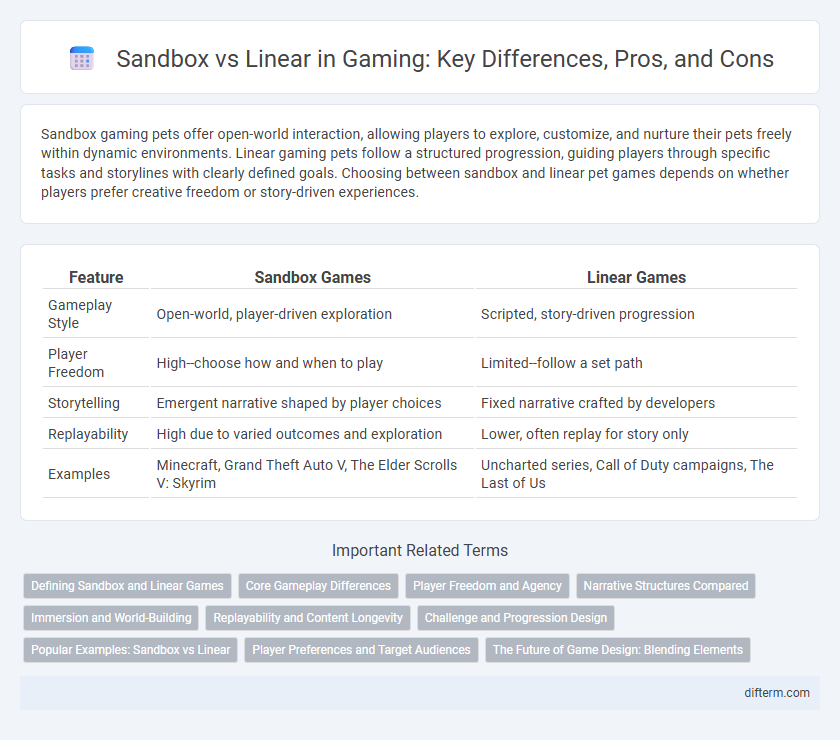Sandbox gaming pets offer open-world interaction, allowing players to explore, customize, and nurture their pets freely within dynamic environments. Linear gaming pets follow a structured progression, guiding players through specific tasks and storylines with clearly defined goals. Choosing between sandbox and linear pet games depends on whether players prefer creative freedom or story-driven experiences.
Table of Comparison
| Feature | Sandbox Games | Linear Games |
|---|---|---|
| Gameplay Style | Open-world, player-driven exploration | Scripted, story-driven progression |
| Player Freedom | High--choose how and when to play | Limited--follow a set path |
| Storytelling | Emergent narrative shaped by player choices | Fixed narrative crafted by developers |
| Replayability | High due to varied outcomes and exploration | Lower, often replay for story only |
| Examples | Minecraft, Grand Theft Auto V, The Elder Scrolls V: Skyrim | Uncharted series, Call of Duty campaigns, The Last of Us |
Defining Sandbox and Linear Games
Sandbox games offer open-world environments where players have the freedom to explore, create, and interact with dynamic systems without strict narrative constraints. Linear games deliver a structured gameplay experience with predefined levels and story progression, guiding players through a specific sequence of events. The key distinction lies in player agency: sandbox games emphasize emergent gameplay and exploration, while linear games focus on tightly controlled storytelling and gameplay pacing.
Core Gameplay Differences
Sandbox games emphasize player freedom with open-world exploration and non-linear objectives, allowing for emergent gameplay and personalized experiences. Linear games guide players through a fixed sequence of levels or missions, focusing on narrative progression and tightly controlled challenges. Core gameplay in sandbox titles centers on creativity and choice, while linear games prioritize story-driven engagement and preset game mechanics.
Player Freedom and Agency
Sandbox games maximize player freedom by offering open worlds where choices directly impact gameplay and narrative, fostering creativity and exploration without predefined paths. Linear games guide players through a structured storyline with limited decision-making, emphasizing controlled pacing and curated experiences. Player agency is significantly heightened in sandbox environments, enabling diverse playstyles and personalized outcomes unmatched by linear designs.
Narrative Structures Compared
Sandbox games offer non-linear narrative structures that enable players to explore multiple story paths and outcomes, fostering a personalized gaming experience. Linear games present fixed storylines with predetermined sequences, creating a focused and tightly woven narrative flow. The choice between sandbox and linear narratives significantly impacts player agency, immersion, and storytelling depth within gaming experiences.
Immersion and World-Building
Sandbox games foster deep immersion through expansive, open worlds where player choices dynamically shape the environment and narrative, enhancing a personalized gaming experience. Linear games deliver tightly crafted storylines with controlled pacing and meticulously designed settings, ensuring a cohesive and immersive atmosphere but limiting player agency. Effective world-building in sandbox titles relies on interactive ecosystems and emergent gameplay, while linear games emphasize detailed lore and scripted events to immerse players.
Replayability and Content Longevity
Sandbox games offer unparalleled replayability by allowing players to explore open worlds with diverse objectives, fostering unique experiences each session. In contrast, linear games deliver tightly crafted narratives with limited branching paths, which can reduce content longevity after initial completion. The open-ended structure of sandbox titles sustains player engagement over extended periods, while linear games often rely on post-launch updates or additional content to maintain interest.
Challenge and Progression Design
Sandbox games offer dynamic challenge and progression design by allowing players to choose their own goals, promoting creativity and adaptive problem-solving skills. Linear games provide structured challenge and progression with carefully paced difficulty curves and clear objectives, ensuring a consistent narrative and skill development. Balancing player freedom in sandbox environments with meaningful progression requires modular challenges and scalable rewards to maintain engagement and a sense of achievement.
Popular Examples: Sandbox vs Linear
Sandbox games such as Minecraft and The Legend of Zelda: Breath of the Wild offer expansive worlds encouraging player exploration and creativity, while linear games like Call of Duty and Uncharted provide tightly scripted narratives with predefined missions. Popular sandbox titles emphasize open-ended gameplay, non-linear progression, and user-driven objectives, contrasting with the focused story arcs and guided experiences typical of linear games. Players seeking freedom and emergent gameplay often prefer sandbox formats, whereas those looking for cinematic storytelling and structured challenges gravitate towards linear designs.
Player Preferences and Target Audiences
Sandbox games attract players who enjoy freedom, exploration, and creativity, appealing primarily to open-world enthusiasts seeking non-linear gameplay and emergent experiences. Linear games cater to players who prefer structured narratives, guided challenges, and defined progression, often targeting casual gamers or those who value story-driven content. Player preferences greatly influence design choices, with sandbox titles emphasizing player agency and linear games focusing on curated storytelling.
The Future of Game Design: Blending Elements
Game design is evolving by blending sandbox freedom with linear storytelling to create immersive experiences that cater to diverse player preferences. Open-world mechanics combined with structured narratives allow developers to offer dynamic gameplay and meaningful progression. This hybrid approach leverages procedural generation and scripted events to balance exploration with focused objectives, shaping the future of interactive entertainment.
sandbox vs linear Infographic

 difterm.com
difterm.com